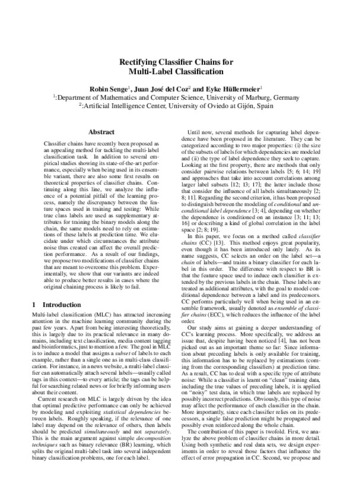Rectifying classifier chains for multi-label classification
Autor(es) y otros:
Fecha de publicación:
Citación:
Resumen:
Classifier chains have recently been proposed as an appealing method for tackling the multi-label classification task. In addition to several empirical studies showing its state-of-the-art performance, especially when being used in its ensemble variant, there are also some first results on theoretical properties of classifier chains. Continuing along this line, we analyze the influence of a potential pitfall of the learning process, namely the discrepancy between the feature spaces used in training and testing: While true class labels are used as supplementary attributes for training the binary models along the chain, the same models need to rely on estimations of these labels at prediction time. We elucidate under which circumstances the attribute noise thus created can affect the overall prediction performance. As a result of our findings, we propose two modifications of classifier chains that are meant to overcome this problem. Experimentally, we show that our variants are indeed able to produce better results in cases where the original chaining process is likely to fail
Classifier chains have recently been proposed as an appealing method for tackling the multi-label classification task. In addition to several empirical studies showing its state-of-the-art performance, especially when being used in its ensemble variant, there are also some first results on theoretical properties of classifier chains. Continuing along this line, we analyze the influence of a potential pitfall of the learning process, namely the discrepancy between the feature spaces used in training and testing: While true class labels are used as supplementary attributes for training the binary models along the chain, the same models need to rely on estimations of these labels at prediction time. We elucidate under which circumstances the attribute noise thus created can affect the overall prediction performance. As a result of our findings, we propose two modifications of classifier chains that are meant to overcome this problem. Experimentally, we show that our variants are indeed able to produce better results in cases where the original chaining process is likely to fail
Colecciones
- Artículos [35482]
- Informática [770]
Ficheros en el ítem




